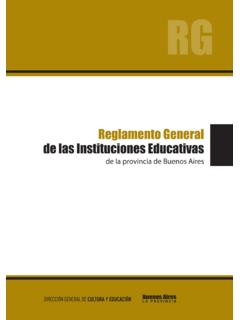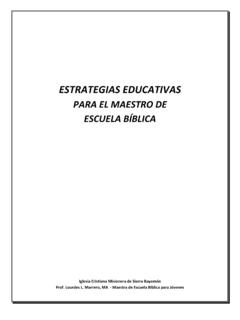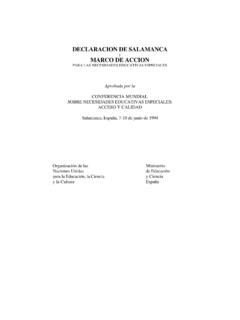Transcription of EDUCATION POLICY OUTLOOK SPAIN - OECD.org
1 EDUCATION POLICY OUTLOOK : SPAIN OECD 20131 April 2014 EDUCATION POLICY OUTLOOK SPAIN EDUCATION POLICY OUTLOOK : SPAIN OECD 20132 EDUCATION POLICY OUTLOOK This POLICY profile on EDUCATION in SPAIN is part of the new EDUCATION POLICY OUTLOOK series, which will present comparative analysis of EDUCATION policies and reforms across OECD countries. Building on the substantial comparative and sectorial POLICY knowledge base available within the OECD, the series will result in a biennial publication (first volume in 2014). It will develop a comparative OUTLOOK on EDUCATION POLICY by providing: a) analysis of individual countries educational context, challenges and policies ( EDUCATION POLICY profiles) and of international trends and b) comparative insight on policies and reforms on selected topics.
2 Designed for POLICY makers, analysts and practitioners who seek information and analysis of EDUCATION POLICY taking into account the importance of national context, the country POLICY profiles will offer constructive analysis of EDUCATION POLICY in a comparative format. Each profile will review the current context and situation of the country s EDUCATION system and examine its challenges and POLICY responses, according to six POLICY levers that support improvement: Students: How to raise outcomes for all in terms of 1) equity and quality and 2) preparing students for the future Institutions: How to raise quality through 3) school improvement and 4) evaluation and assessment System: How the system is organised to deliver EDUCATION POLICY in terms of 5) governance and 6) funding.
3 Some country POLICY profiles will contain spotlight boxes on selected POLICY issues. They are meant to draw attention to specific policies that are promising or showing positive results and may be relevant for other countries. Special thanks to the Spanish Government for their active input during consultations and constructive feedback on this report. Authors: This country POLICY profile was prepared by Beatriz Pont, Diana Toledo Figueroa, Etienne Albiser, D sir e Wittenberg, Juliana Zapata, and Sylvain Fraccola (statistics and design), from the EDUCATION POLICY OUTLOOK team, which is part of the POLICY Advice and Implementation Division, led by Richard Yelland.
4 Editorial support was provided by Lynda Hawe and Susan Copeland. This profile builds on the knowledge and expertise of many project teams across the OECD s Directorate for EDUCATION and Skills, to whom we are grateful. Sources: This country profile draws on OECD indicators from the Programme for International Student Assessment (PISA), the Teaching and Learning International Survey (TALIS), the Survey of Adult Skills and the annual publication EDUCATION at a Glance, and refers to country and thematic studies such as OECD work on early childhood EDUCATION and care, teachers, school leadership, evaluation and assessment for improving school outcomes, equity and quality in EDUCATION , governing complex EDUCATION systems, vocational EDUCATION and training, and tertiary EDUCATION .
5 Most of the figures quoted in the different sections refer to Annex B, which presents a table of the main indicators for the different sources used throughout the country profile. Hyperlinks to the reference publications are included throughout the text for ease of reading, and also in the References and further reading section, which lists both OECD and non-OECD sources. More information is available from the OECD Directorate for EDUCATION and Skills ( ) and its web pages on EDUCATION POLICY OUTLOOK ( ). For further information, you are invited to contact the OECD s EDUCATION POLICY OUTLOOK Team EDUCATION POLICY OUTLOOK : SPAIN OECD 20133 TABLE OF CONTENTS Highlights.
6 4 Equity and quality Early start in EDUCATION but barriers to equity and high dropout rate .. 6 Preparing students for the future Higher EDUCATION attainment for better labour market outcomes .. 8 School improvement Pedagogical development for teachers and school leaders to improve student 10 Evaluation and assessment to improve student outcomes National and regional collaboration on EDUCATION evaluation .. 12 Governance Regional autonomy within a centralised framework .. 14 Funding Autonomous resource management .. 16 Annex A: Structure of SPAIN 's EDUCATION system .. 18 Annex B: Statistics .. 19 References and further reading.
7 23 Figures Figure 1. Performance of adults in literacy, of 15-year-olds in mathematics and impact of ESCS .. 5 Figure 2. Upper secondary and tertiary attainment .. 5 Figure 3. Low and top performers and difference between non-immigrant and immigrant students .. 7 Figure 4. Students in EDUCATION and not in EDUCATION , by educational attainment and work status .. 9 Figure 5. The learning environment .. 11 Figure 6. Student assessment by purpose .. 13 Figure 7. Decisions in public lower secondary schools, by level of government .. 15 Figure 8. Expenditure on educational institutions as a percentage of GDP.
8 17 Spotlights Spotlight 1. Efforts to strengthen the quality of EDUCATION and prevent dropout .. 7 Spotlight 2. Enhancing university EDUCATION in SPAIN .. 9 EDUCATION POLICY OUTLOOK : SPAIN OECD 20134 HIGHLIGHTS SPAIN s educational context Students: For 15-year-old students in SPAIN , achievement has remained below the OECD average over the years, while the impact of socio-economic background on mathematics performance is slightly above the OECD average, according to PISA. Spanish 16-24 year-olds are more proficient than the overall adult population, but perform below the average of their peers in other countries participating in the OECD Survey of Adult Skills.
9 SPAIN has close to 100% enrolment in early childhood EDUCATION and comprehensive EDUCATION for all students until age 16. Grade repetition hampers equity and completion; enrolment in VET is lower than the OECD average; and dropout rates from upper secondary EDUCATION are high among students from disadvantaged socio-economic backgrounds. Tertiary enrolment and attainment have increased to the OECD average. Those with lower educational attainment are particularly affected by unemployment, more than in most OECD countries. Also, youth unemployment has risen sharply, with almost 25% of SPAIN s youth population neither employed, nor in EDUCATION or training in 2011.
10 Institutions: Spanish learning environments are positive, according to the views of 15-year-old students. The ratio of students per teacher is below the OECD average at all levels of EDUCATION . Principals are elected or selected from among teaching staff and follow a short training course. They tend to focus more on administrative tasks than pedagogical leadership. Salaries for teachers are competitive in relation to workers with similar experience. Spanish teachers have access to professional development, but appraisal opportunities seem less common for teachers in SPAIN than for their counterparts in other countries.















